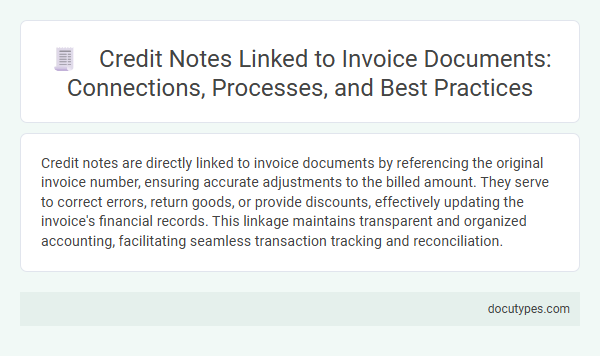Credit notes are directly linked to invoice documents by referencing the original invoice number, ensuring accurate adjustments to the billed amount. They serve to correct errors, return goods, or provide discounts, effectively updating the invoice's financial records. This linkage maintains transparent and organized accounting, facilitating seamless transaction tracking and reconciliation.
Introduction to Credit Notes in Invoice Management
Credit notes are essential financial documents used in invoice management to correct or adjust previously issued invoices. They serve as official records indicating a reduction in the amount owed by the customer.
In invoice management, credit notes are directly linked to specific invoice documents to ensure accurate tracking of transactions and adjustments. This connection helps maintain transparent financial records and facilitates precise account reconciliation.
Defining Credit Notes: Purpose and Importance
Credit notes serve as official documents issued to correct or adjust previously issued invoices. They play a crucial role in maintaining accurate financial records and customer trust.
- Credit notes represent adjustments - They are linked to invoice documents to rectify errors such as overcharges or returned goods.
- Credit notes ensure accounting accuracy - By reflecting credits granted, they help balance accounts receivable and payable precisely.
- Credit notes support transparency - They provide a clear audit trail for financial corrections associated with specific invoices.
The Connection Between Invoices and Credit Notes
Credit notes are directly linked to invoice documents to adjust or correct previously issued invoices. This connection ensures accurate financial records and clear communication between parties.
- Reference to Original Invoice - Credit notes always cite the specific invoice number they modify, establishing a clear audit trail.
- Adjustment of Amounts - They reflect changes like discounts, returns, or errors by decreasing the original invoice total.
- Maintaining Ledger Accuracy - Linking credit notes to invoices helps keep your accounting and tax documentation precise and compliant.
Understanding this relationship helps you manage billing and refunds efficiently.
Common Scenarios for Issuing Credit Notes
Credit notes are directly linked to invoice documents as adjustments that correct or reduce the amount originally billed. Common scenarios for issuing credit notes include returned goods, pricing errors, or discounts applied after the original invoice. These documents ensure accurate financial records and customer account balances by referencing the specific invoice they amend.
Step-by-Step Process for Linking Credit Notes to Invoices
Credit notes are essential documents that adjust or correct invoices by reducing the amount payable. Linking credit notes to invoice documents ensures accurate financial records and transparent transaction histories.
You begin by identifying the original invoice that requires adjustment. Next, create a credit note referencing the invoice number and specify the amount to be credited.
Enter the credit note details into your invoicing or accounting system, ensuring it is tagged to the corresponding invoice. This linkage enables automatic updates to outstanding balances and enhances audit trail integrity.
Review and approve the credit note to finalize the connection with the invoice. The system will then reflect the adjusted invoice total, maintaining consistency across your financial reports.
Key Data Fields in Credit Notes and Associated Invoices
| Key Data Field | Description | Relation to Invoice |
|---|---|---|
| Credit Note Number | Unique identifier for the credit note document | References the specific credit note issued against the original invoice |
| Original Invoice Number | Identifier of the invoice to which the credit note applies | Links the credit note directly to the corresponding invoice record |
| Issue Date | Date when the credit note was created | Helps track timing relative to the original invoice date |
| Customer Details | Information such as customer name, address, and contact | Ensures credit note aligns with the invoice recipient |
| Credit Amount | The amount being credited back | Corresponds to adjustments made on the invoice total |
| Reason for Credit | Explanation for the credit note issuance | Justifies modifications reflected in the original invoice |
| Tax Information | Details of applicable taxes on the credit amount | Should match or adjust taxes from the original invoice accordingly |
You can efficiently reconcile your accounting records by ensuring credit notes contain these key data fields linked precisely to the original invoices.
Automation of Credit Note and Invoice Reconciliation
How are credit notes linked to invoice documents in automated systems? Automated credit note and invoice reconciliation improves accuracy by matching transaction details such as invoice numbers, amounts, and dates. This process reduces manual errors and accelerates financial closing cycles.
Compliance and Audit Trail Considerations
Credit notes are directly linked to invoice documents through unique reference numbers, ensuring accurate adjustment of original billing amounts. Maintaining this linkage is critical for compliance, as it provides a clear audit trail that verifies transaction legitimacy and financial accuracy. Regulatory frameworks often mandate this connection to prevent fraud and support transparent financial reporting during audits.
Best Practices for Credit Note Handling
Credit notes must be properly linked to their original invoice documents to ensure accurate financial records. Understanding best practices for credit note handling helps maintain transparency and facilitates efficient accounting processes.
- Reference the Original Invoice Number - Always include the original invoice number on the credit note to create a clear connection between the documents.
- Record Credit Notes Promptly - Timely documentation of credit notes prevents discrepancies in accounts receivable and financial reporting.
- Maintain Audit Trails - Keep detailed records of credit notes and related invoices to support audits and resolve disputes efficiently.
How Are Credit Notes Linked to Invoice Documents? Infographic

